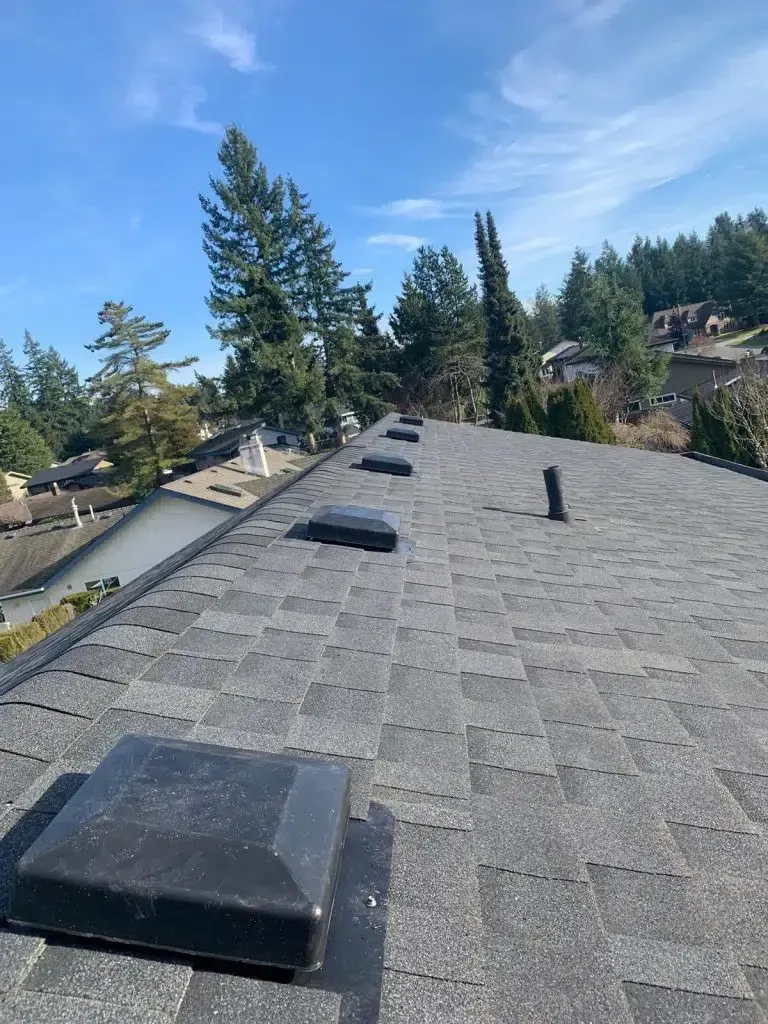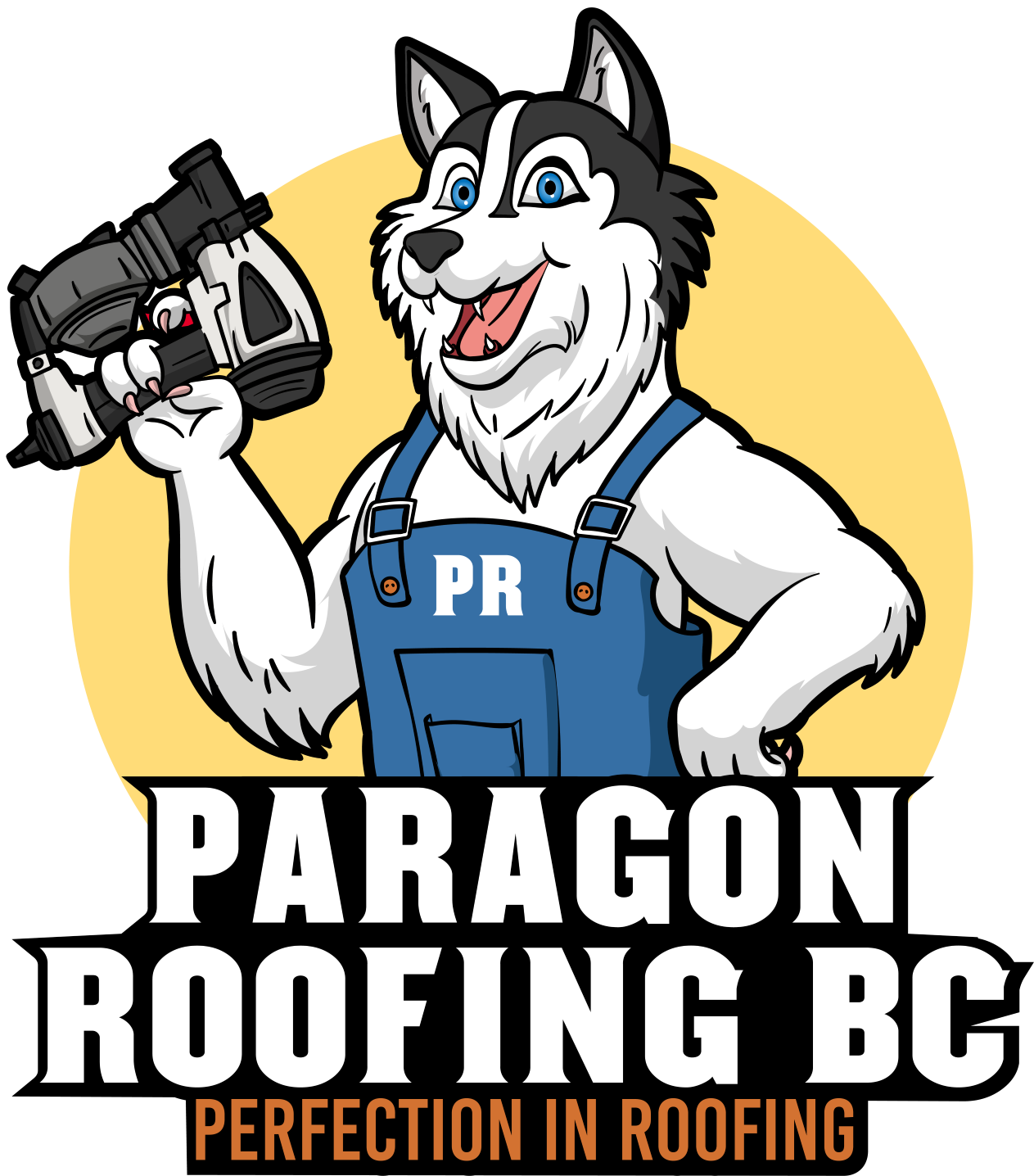Why Roof Ventilation Matters in Burnaby’s Wet Climate
Burnaby roof ventilation stops rain-driven moisture from saturating attics, slashing rot, mould, and energy waste in our soggy coastal weather.
- Block mildew by exhausting humid indoor air outward fast.
- Drain roof deck condensation before rot can start.
- Stabilize shingle temperature to avoid ice-dam melt-freeze cycles.
- Lower cooling loads by venting summer attic heat.
- Meet BC Code ratio 1/300 vent area easily.
The Rain Never Quits—And Neither Should Your Attic’s Airflow
November drops an average 354 mm of rain across 20 stormy days, while the year as a whole soaks up ≈ 2,391 mm over 171 precipitation-packed days —double Vancouver Island’s drier east coast, and more than twice Toronto’s annual tally. That relentless damp doesn’t just wet your jacket; it migrates upward, slips through insulation, and condenses the moment it meets a cold roof deck.
Left unchecked, moisture morphs into hidden decay. Rafters swell. Plywood delaminates. Black mould dusts the underside of your sheathing and spore-bombs the living space below. That’s why every ridge, soffit, or gable vent is more than sheet-metal bling—it’s a pressure-release valve for an entire microclimate brewing inside your roof.
How Moisture Sneaks In—And What Burnaby’s Climate Adds to the Mix
Burnaby’s maritime setting means mild sea-air meets cooler alpine gusts multiple times a day, spiking relative humidity even when skies tease us with sun. The vapor drive is relentless: warm indoor air, buoyed by showers, cooking, and human breathing, rises until it smacks the colder roof line. When outside dew points hover near 100 % (a regular event from October to March), condensation forms instantly.
Now, factor in our impressive rainfall totals and you get “double wetting.” Liquid water seeps downward through capillary action in nail holes and seam gaps, while vapor loads from inside push upward. Without intentional airflow, those moisture streams converge in the attic like opposing rivers—flooding insulation R-value and providing the perfect breeding ground for fungal lunch.
BC Building Code: The 1/300 Rule—Your Minimum, Not Your Goal
British Columbia’s Building Code demands a net free vent area (NFVA) equal to 1 sq ft per 300 sq ft of insulated ceiling area, with at least 25 % high and 25 % low. Think of it as a bare-bones survival rate, not optimal performance. In Burnaby’s rain zone, seasoned roofers aim closer to a 1/150 ratio—especially on low-slope decks where air overturn is sluggish.
Quick math example:
• 2,000 sq ft bungalow → 6.7 sq ft NFVA (Code)
• Target 1/150 → 13.3 sq ft NFVA
• Ridge-vent line of 40 ft (18 in²/ft) provides 5 sq ft NFVA; soffit vents must supply the rest.
Matching high-to-low balance matters. Too much ridge and too little soffit starves airflow; too much soffit without exhaust traps heat. A manometer test after installation is cheap insurance.
Types of Vents and Their Wet-Climate Pros/Cons
| Vent Style | Burnaby Strength | Watch-Out Note |
|---|---|---|
| Continuous ridge | Even pull along peak; hides well under caps | Flashing must resist wind-driven rain |
| Soffit panel | Floods intake quietly; discourages pests | Blocked by attic insulation baffles |
| Gable louver | Good retrofit on steep gables | Creates dead zones near ridge |
| High-capacity box (“turtle”) | Handles complex hip roofs | Add storm collars for sideways squalls |
| Solar-assisted fan | Active in sun; reduces summer heat | Minimal help during dark wet weeks |
Installation Realities Only a Burnaby Roofer Talks About
- Ridge Cap Nailing: We over-nail every other tab and apply butyl strip inside the ridge vent channel, because Pacific frontal systems fling water sideways at 60 km/h.
- Soffit Baffle Depth: Standard 2-in baffles choke under 12-in blown cellulose. Our crew uses 4-in SmartBaffle channels, stapled high to maintain a wind-wash buffer.
- Under-Vent Screens: Stainless-steel mesh, not fiberglass, keeps raccoons from claw-widening holes. After one winter, fiberglass frays like gossamer.
The Physics Behind the Flow—Simplified
Bernoulli tells us wind skimming a ridge lowers pressure above your roof; stack effect tells us warm air rises inside the attic; vapor diffusion whispers through drywall seams all night long. When vents are balanced top and bottom, those forces form a conveyor belt: cooler, drier outside air sweeps in low, picks up moisture, and ejects it high in continuous rhythm. Block one side and you break the belt.
Condensation Case Study: Simon Fraser Hills Split-Level
Problem: Homeowner smelled musty odors after remodeling bathroom but never saw water stains. Thermal camera revealed 18 % moisture content in upper truss chords—borderline rot threshold.
Fix: We opened the sheathing, installed 42 ft of ShingleVent II, cut back insulation to expose soffit slots, and raised NFVA to 1/140.
Result: Six months later, moisture dropped below 10 %, energy audit showed 11 % reduction in winter heating load, and homeowner’s allergy flare-ups vanished.
Energy Payback: More Than a Longevity Play
Proper airflow keeps summer attic temps within 5 °C of ambient. That can shave 10–12 % off cooling costs on the Upper Slope where AC use is rising. In winter, the benefit flips: Less trapped heat beneath shingles means snow melts evenly instead of refreezing at eaves—preventing the ice dams that pry gutters away and flood soffits.
Myth Busting—Quick-Fire Clarifications
- “Extra vents will leak rain.” Only if cut wrong or flashed badly. Vent manufacturers pressure-test to hurricane-grade angles; craft matters more than quantity.
- “My 1950s bungalow breathes fine through gaps.” With new spray-foam encapsulations and Air-Tight BC renos, those gaps disappear. Vent before you seal.
- “Can I rely on bathroom fans alone?” Fans exhaust inside air but don’t introduce fresh makeup air or relieve deck moisture.
DIY Vent Calculation Roadmap
- Measure attic floor area in square feet.
- Divide by 150 for Burnaby rains.
- Convert sq ft to sq in (×144).
- Allocate 50 % to intake, 50 % to exhaust.
- Select vents whose NFVA data meet or exceed those numbers.
Choosing Materials That Withstand Soaking Rains
Aluminum and galvalume resist salt-laden Fraser River mist better than cheap plastic caps, which become UV-brittle by year eight. Stainless screws and neoprene washers beat roofing nails through vent flanges, preventing rust drip lines down shingles.
Maintenance Checklist for Year-Round Performance
- Spring – Brush soffit screens free of fir needles.
- Summer – Inspect ridge caps for sealant cracks.
- Autumn – Clear moss around box vents to prevent damming.
- Winter – Check attic humidity; target <60 % RH at 5 °C.
Set reminders: a 15-minute attic walkabout each season saves thousands.
The Cost Equation—Short-Term Spend, Decades-Long Savings
A full ridge-and-soffit upgrade on a 2,400 sq ft Burnaby home runs $2,800–$5,000, depending on roof complexity and plywood repair allowance. Compare that to $12,000–$20,000 for structural rot and mould remediation, or the $800/year energy penalty of a super-heated attic. Ventilation isn’t glamorous, but it’s the best insurance you can nail down.
Final Thoughts from a Roofer Who Sees the Attics Others Only Imagine
After two decades scaling Burnaby’s chimneys in sideways rain, I’ve learned one immutable rule: water will find the weakness you don’t ventilate. Give damp air an easy exit and your shingles, insulation, and lungs will all breathe easier. Ignore it, and every storm is silently shortening your roof’s lifespan. Choose the first path—it’s drier, safer, and far cheaper in the long run.
roof ventilation solutions in Burnaby
References
- British Columbia Building Code: Roof Space Ventilation, 9.19.1 (accessed 2025).
- Weather-and-Climate.com, “Average Monthly Rainy Days in Burnaby” (2024).
- Weatherspark.com, “Average Rainfall in Burnaby” (2024).



